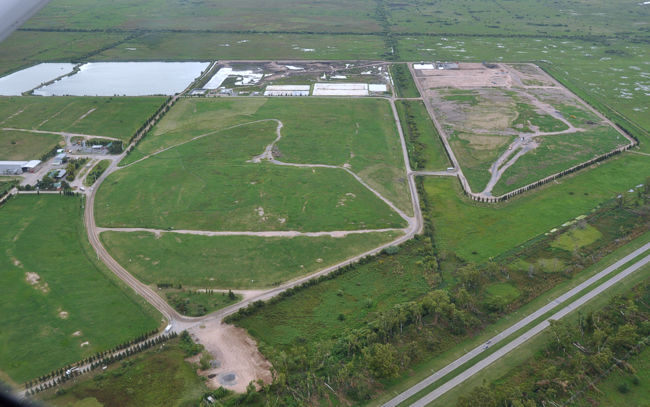In a world where urban waste continues to grow and water stress intensifies, every mismanaged drop represents a missed opportunity. This project in Ensenada, Buenos Aires Province, dares to flip that logic: instead of treating leachate as a toxic liability, it transforms it into a regenerated source of usable water. Located in a sensitive zone marked by the interplay of urban areas, wetlands, and strategic aquifers, the Ensenada landfill presents both a latent threat and a platform for structural change. Today, each untreated cubic meter of leachate means contamination of the Puelche aquifer, unnecessary emissions, and public health risks. Tomorrow, thanks to a double-stage reverse osmosis system, that same water will be reused on-site for industrial irrigation, truck washing, or dust suppression. This shift is not just technical, it is strategic. It proves that a circular water economy is viable, even from waste management.
Located within the Río Santiago watershed and affecting tributaries such as El Gato and Rodríguez streams, the project addresses fragile hydrogeological conditions and growing climate pressures. Through a modular, automated, and traceable treatment system, the landfill operator, alongside a specialized technology provider and technical support from institutions like UNLP or INTI, undertakes the challenge of turning liquid waste into a valuable resource. Traceability is ensured through real-time sensors, certified laboratories, and a digital platform aligned with Aqua Positive, enabling reporting under the VWBA 2.0 methodology, with the potential to also integrate WQBA-based water quality benefits.
More than just a treatment plant, this project sets a new operational standard: additional, intentional, and verifiable. The outcome is not only a recovered volume , estimated between 50 and 100 m³/day , but a clear signal that regenerative water management must be embedded into urban infrastructure. And when the scale of the crisis is measured in thousands of tons of annual leachate, any solution that closes the water loop and avoids contaminated discharges is, quite simply, essential
The challenge is clear: each year, the Ensenada landfill accumulates thousands of cubic meters of leachate without effective treatment, creating growing environmental liabilities, legal risks, and unsustainable operational costs. The current model, based on evaporation lagoons and off-site transport, can no longer withstand climate pressure or meet regulatory expectations. But therein lies the opportunity: to install a treatment and reuse system that turns this waste into a water asset.
The technical solution relies on double-stage reverse osmosis with physicochemical pretreatment, full automation, and modular scalability. This is a robust, proven technology capable of removing over 90% of critical pollutants, COD, ammoniacal nitrogen, heavy metals, and generating reusable water for on-site non-potable uses. The system can treat 50 to 100 m³/day of leachate, with permeate reused for dust suppression, vehicle washing, or irrigation. Every liter reused means less freshwater extraction, less toxic infiltration, less external transport, and greater resilience during extreme rainfall events.
This model is not only replicable, it is urgent. Any landfill located in hydrologically stressed zones, under tightening regulations and growing community pressure, can benefit from this approach. Waste operators, local governments, or ESG-driven public-private alliances will find a multi-fold return: reduced environmental risks, improved reputation, and full traceability under VWBA and WQBA standards. In this sense, the project does not just transform a single site; it transforms the baseline of what is possible. Becoming a protagonist in this transition is not a reputational luxury , it is a competitive imperative.
The proposed solution involves deploying an advanced leachate treatment plant specifically designed for variable flow and pollutant loads, typical of Ensenada’s final disposal site. The core technology is double-stage reverse osmosis, recognized for its high efficiency in removing both organic and inorganic contaminants, producing non-potable water suitable for reuse.
Process stages include:
The infrastructure also includes a fully automated system designed for variable flow conditions, real-time monitoring of key parameters, and self-regulation to maximize recovery and minimize waste. This solution redefines landfill water management,from disposal to sustainable recovery and reuse.
Technology:
Monitoring and Control Plan:
Stakeholders:
This project represents a paradigm shift in leachate management in urban-industrial settings like Ensenada. It moves away from traditional accumulation and disposal of hazardous waste toward regenerative management,turning leachate into a resource for site operations.
Environmental benefits: every liter of treated and reused leachate reduces pressure on freshwater sources, mitigates aquifer contamination risks, and lessens surface discharge impacts.
Operational benefits: lower costs in transport, off-site treatment, and potable water use, while increasing the landfill’s resilience to heavy rain events.
Beyond meeting VWBA criteria, the project aligns with broader sustainability commitments, environmental governance, and circular economy strategies. Traceability via platforms like Aqua Positive adds reputational and commercial value to performance.
System capabilities:
• Treat 50–100 m³/day of leachate with efficiency, adjusting to seasonal flow.
• Remove over 90% of critical contaminants (COD, ammonium, heavy metals, nitrates, conductivity).
• Prevent infiltration, overflow, and accidental discharge with a closed-loop treatment and recirculation system.
• Demonstrate additionality,this high-efficiency treatment and reuse would not occur without the project.
• Guarantee traceability through digitized records and third-party verification.
• Ensure permanence via long system life, modular design, and integration into daily landfill operations.
Timeline and Permanence:
• Timeline: Benefits are calculated annually but can be averaged over three years to smooth seasonal fluctuations.
• Permanence: As long as the system operates with traceability, the benefit is considered permanent. Estimated useful life: minimum 10 years.
